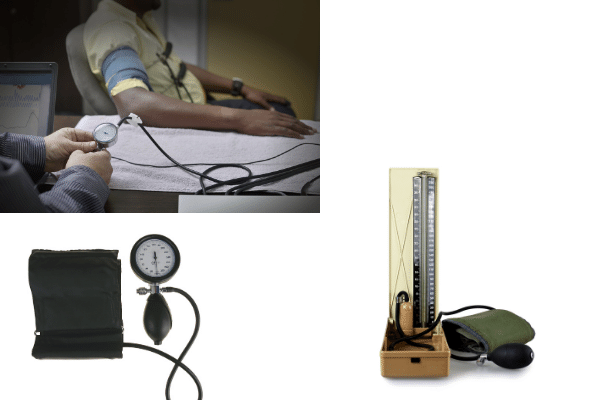Should I use an electronic blood pressure monitor or a mercury blood pressure monitor to measure my blood pressure at home?
2021-03-17
The other day, a senior patient with a 10-year history of hypertension came to my office with three different brands of electronic blood pressure monitors, one wrist-type electronic blood pressure monitor, and two upper-arm electronic blood pressure monitors. He always felt that his blood pressure monitor is inaccurate and wanted to come to the hospital to calibrate it, by the way, to consult what brand and what type of blood pressure monitor is better to buy, very have the idea of purchasing another one.
In the past two years, more and more hypertension patients are being seen in hospitals, and there is a trend toward younger people. Hypertension is the most critical risk factor for myocardial infarction, stroke, heart failure, and kidney failure.
In addition to the routine blood pressure measurement in the office, I usually ask patients who can do so to take their blood pressure at home or call home self-measurement. Still, confusingly, many patients tell me that their home electronic blood pressure monitor is not accurate, and some collect it and do not use it anymore, including some medical professionals. However, for patients with hypertension, home self-measurement of blood pressure is very important and can significantly improve the awareness, treatment, and control of hypertension.
Since home self-measurement of blood pressure is so important, the question arises.
Is it better to choose a mercury column sphygmomanometer or an electronic sphygmomanometer?
The mercury column sphygmomanometer is currently the most commonly used in hospital clinics; the user is usually a hospital professional and needs to be equipped with a stethoscope to accurately measure blood pressure, which requires some professional training, including the switch of the sphygmomanometer, which requires specific skills, otherwise it may lead to the leakage of mercury and lead to inaccuracy of the sphygmomanometer. Ps: hospital mercury sphygmomanometers also need to be regularly checked every year—the effectiveness of the accurate.
And mercury is a severe danger to the human body of heavy metals. It may lead to environmental pollution, so the family self-measurement of blood pressure, we generally do not recommend the use of mercury column sphygmomanometer, but urged electronic sphygmomanometer, which has the advantages of lightweight instruments, no pollution, easy to carry out, simple operation steps, etc., some can also voice broadcast blood pressure values and warning of higher blood pressure, especially for the elderly.

So which electronic blood pressure monitor should we use?
There are generally three types of electronic blood pressure monitors on the market: upper arm type electronic blood pressure monitor, wrist type blood pressure monitor, finger type blood pressure monitor; how should we choose when buying?
Finger sphygmomanometer: We do not recommend using it because its measurement value may be different from the upper arm blood pressure, and there are more variations.
Wrist blood pressure monitor:We also do not recommend using its measurement value as the "wrist pulse pressure value."
The same may occur in error, only for cold undressing inconvenience or mobility disabilities.
Other exceptional circumstances can be considered instead of using.
Upper arm type automatic electronic blood pressure monitor: recommended for home self-measurement blood pressure. It is mainly through the oscillometric method of indirect blood pressure measurement; the market blood pressure monitor is mixed. We recommend using a certified electronic blood pressure monitor for home blood pressure measurement. Certified international programs are mainly (ESH, BSH, AAMI), China recommends using ESH standards. It is best to choose a large brand with good after-sales service, more vital technical force, better stability of the sphygmomanometer. At the same time, it is best to send to the after-sales fixed-point calibration once a year for the use of a relatively long time; you can consider replacing it.
Why do people feel that the electronic blood pressure monitor is not accurate?
This problem because of the impact of more factors, according to experience and my weekday feedback from these patients, mainly for the following reasons.
One. most of the family self-measurement blood pressure will be a little lower than the measurement in the hospital, and in the hospital measurement when some patients are more nervous may have a white coat phenomenon, resulting in higher blood pressure in the hospital, patients mistakenly believe that their blood pressure monitor is not accurate. Clinic blood pressure ≥ 140/90mmHg for hypertension, and home self-measured blood pressure ≥ 135/85mmHg for hypertension; the two standards are not the same.
Two. the measurement of blood pressure is not standardized; the cuff is not tied to the proper tightness and position, the measurement method is not correct, the timing is not right. Some patients measure while talking loudly on the phone, or measure immediately after doing housework or exercising, or measure just after eating, smoking, or drinking coffee, all of which can lead to inaccurate blood pressure measurement.
Three. Some patients also tell me that their blood pressure is not the same every time they measure it during the day, so they think it is inaccurate. The blood pressure of both healthy and hypertensive patients is dynamic. It cannot be exactly the same, generally higher in the morning and lower at night, showing diurnal variations. The fluctuations in the elderly will be greater than in young people, as long as the changes are within a specific safe range are average.
Four. Repeated measurements within a short period may cause changes in blood pressure measurements, and older adults have poor vascular elasticity and are especially prone to significant differences in multiple sizes. After a single measure of high blood pressure, emotional tension may also lead to higher and higher blood pressure values. This is also very common in clinical practice, and some patients are even admitted to the hospital as a result.
Five.may electronic sphygmomanometer sensor and another electronic system failure, may also be no battery. It should be noted that the electronic blood pressure monitor also needs to be calibrated regularly.
If you can't find the cause and can't decide, see your doctor for a checkup.
When is the best time to measure blood pressure?
Measure your blood pressure two to three times a day after you wake up in the morning (6:00 to 9:00) and at night (18:00 to 21:00), one minute apart, and take the average value. For first-time patients, patients in the early stages of treatment, or patients whose blood pressure does not meet the standard and is unstable after treatment, it is recommended that measurements be taken for seven consecutive days before the visit. When blood pressure is well controlled, measures can be taken once a week.
Is it better to measure the left hand or the right hand?
This is also a question that many patients ask here to explain, and it does not matter male left and female right. Usually, we measure the blood pressure of the right upper arm; of course, on the first visit, it is generally recommended that both left and right sides be measured to screen for some vascular lesions, usually to the high side of the blood pressure prevail.
The above is for you to organize about choosing a home blood pressure monitor and often encounter some problems, maysino is a medical blood pressure monitor supplier.
If you have questions, please contact us. We will reply as soon as possible.

